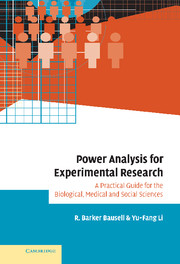 Power Analysis for Experimental Research
Power Analysis for Experimental Research Book contents
- Frontmatter
- Contents
- Introduction
- 1 The conceptual underpinnings of statistical power
- 2 Strategies for increasing statistical power
- 3 General guidelines for conducting a power analysis
- 4 The t-test for independent samples
- 5 The paired t-test
- 6 One-way between subjects analysis of variance
- 7 One-way between subjects analysis of covariance
- 8 One-way repeated measures analysis of variance
- 9 Interaction effects for factorial analysis of variance
- 10 Power analysis for more complex designs
- 11 Other power analytic issues and resources for addressing them
- Technical appendix
- Bibliography
- Index
4 - The t-test for independent samples
Published online by Cambridge University Press: 28 August 2009
- Frontmatter
- Contents
- Introduction
- 1 The conceptual underpinnings of statistical power
- 2 Strategies for increasing statistical power
- 3 General guidelines for conducting a power analysis
- 4 The t-test for independent samples
- 5 The paired t-test
- 6 One-way between subjects analysis of variance
- 7 One-way between subjects analysis of covariance
- 8 One-way repeated measures analysis of variance
- 9 Interaction effects for factorial analysis of variance
- 10 Power analysis for more complex designs
- 11 Other power analytic issues and resources for addressing them
- Technical appendix
- Bibliography
- Index
Summary
Purpose of the statistic
The t-test for independent samples is used to ascertain how likely an observed mean difference between two groups would be to occur by chance alone. The groups may be experimental conditions to which subjects have been randomly assigned (e.g., an intervention vs. a control), a naturally occurring dichotomy (e.g., a comparison among males and females), or a binary comparison of any sort (e.g., smokers vs. non-smokers) as long as the two groups are not made up of the same or matched subjects.
The independent samples t-test, then, is used when:
there is a single, dichotomous independent variable (e.g., two discrete groups),
the dependent variable is continuous in nature,
the hypothesis to be tested is expressed in terms of a mean difference, and
the subjects or observations contained in the two groups are independent of one another (e.g., they have been randomly assigned or assigned by some non-matched manner).
The independent samples t-test is not used when:
there is more than one independent variable such as a covariate (which is used strictly for statistical control purposes) or a blocking variable (which is used to ascertain if one type of subject responds differently to the intervention),
this single independent variable is continuous in nature or contains more than two groups,
the hypothesis is expressed in terms of a relationship between variables rather than a difference between groups,
the dependent variable is categorical in nature, or
[…]
- Type
- Chapter
- Information
- Power Analysis for Experimental ResearchA Practical Guide for the Biological, Medical and Social Sciences, pp. 50 - 56Publisher: Cambridge University PressPrint publication year: 2002


